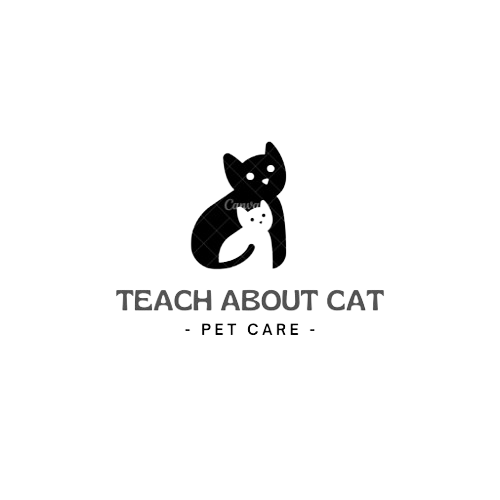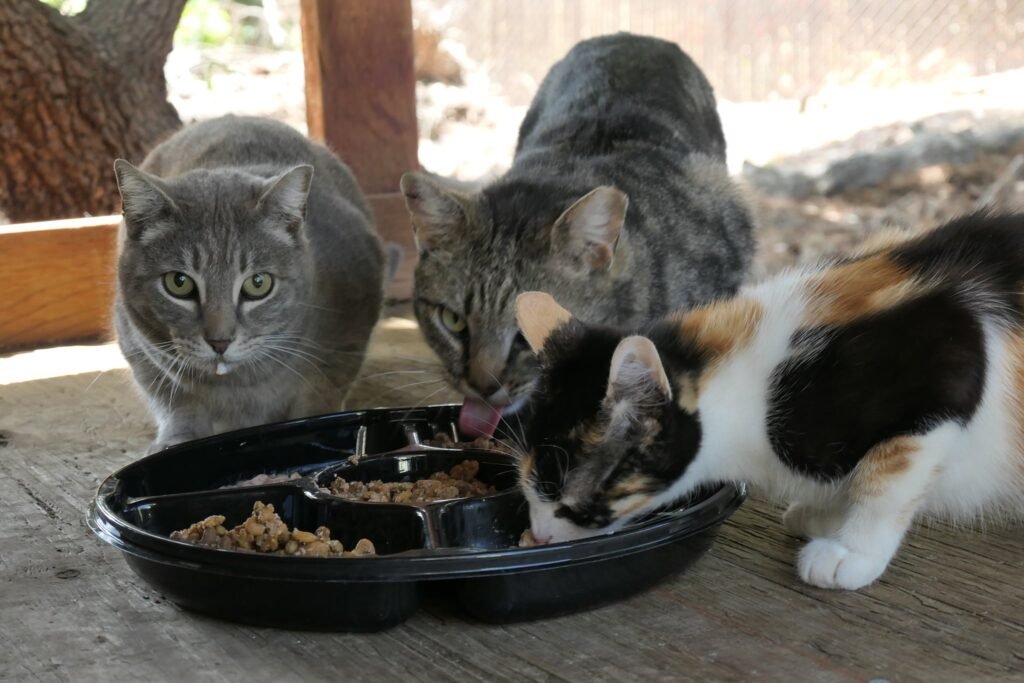In the intriguing world of feline dynamics, it’s quite frustrating when one cat steals the other cat’s food. Often, this behavior is not just about being hungry; it’s a complex interplay of factors like different diets, particularly if one cat’s food is tailored for specific health reasons and inadvertently tastes better to the other. This can lead to a form of bullying behavior, where the stealing cat asserts dominance over the other, especially in multi-cat households.
Cat Eats other Cats Food
In the realm of feline dining etiquette, the enigma of “Cat Eats Other Cat’s Food” unveils a tale of territorial instincts and culinary preference. Beyond mere hunger, it reflects a delicate balance of resource guarding and technological solutions like microchip feeders, shaping the dynamics within multi-cat households. Understanding these intricacies is key to fostering harmony and ensuring each furry friend enjoys their meal without interference.

Reasons Why Your Cat Might Be Stealing Your other Cat’s Food
-
Resource Guarding And Bullying
Domestic cats, by nature, are solitary animals that, in the wild, would live alone within a well-defined territory. Even in a household setting, where they may form bonded pairs or groups, they can sometimes fail to fully adapt to this communal living.
This is especially true when it comes to sharing key resources like food. They carry an instinct to survive as solitary hunters, which often means they don’t willingly go around sharing food, a vital survival resource. In a multi-cat household, conflict can arise, often in ways that are subtle and easily missed by the human family.
What might be dismissed as playing could be a sign of feline aggression. For instance, stealing another cat’s food is not just about hunger, but can be a form of resource guarding. It’s not fine in a feline household for one cat to block access to important resources.
This might involve using their body angle to guard bowls, keeping others away while they gobble up the food, or even just watches the other cat eat. What might look like one cat letting another eat is important to note. Owners must realize that the seemingly unbothered cat might actually resent this behavior. Cat behaviors are complex, and it’s easy to miss these subtle signs of stress.
Also Read: Can Cats Eat Fish Food?
-
It Tastes Better
Among various reasons why a cat might be stealing food from another, a key factor often lies in the taste and composition of the diets. Cats on different diets, especially for medical reasons or due to different ages, may find certain foods more interesting and palatable. For instance, kitten food, known for its higher protein content, might be tastier to an adult cat, leading to the adult stealing the kitten’s food. This behavior isn’t just whimsical; it’s driven by the inherent appeal of richer, more flavorful food.
However, this stealing habit isn’t without consequences, especially when cats have specific health needs. Cats with obesity, diabetes, hyperthyroidism, kidney disease, or irritable bowel disease (IBD) often have diets tailored to their nutritional requirements. For example, cats on kidney diets usually consume food with lower protein levels, while those on diets for obesity might have meals with reduced fats.
These diets, though essential, can be less palatable and, frankly, quite frustrating for the cat. The challenge intensifies when the cat, for whom the special diet is not intended, starts stealing food from the other, potentially doing harm to both animals.
On the other hand, when the other cat has a medical issue, the foods they consume, like those for gut issues or recovery diets for senior cats, can be ultra-palatable. In a typical diet scenario, trying to steal food from a cat without a medical condition is less likely to cause problems than the other way around.
This is particularly significant with expensive and specialized nutrition they need. Understanding and managing these dietary preferences and necessities in a multi-cat household is crucial to ensure the well-being of all pets involved.
-
They Prefer The Bowl Or Area
In the intriguing realm of cat behavior, one lesser-known reason why a cat might be stealing food from another revolves around their inherent nature as creatures of habit and routine. Cats, valuing security and consistency, often form preferences from a young age and may struggle when expected to move or use different bowls for feeding. If you’re feeding them in different places around the house, it’s not uncommon for one cat to develop a fondness for the bowl or area where the other cat eats.
-
They’re Still Hungry
- Hunger is a straightforward reason for a cat to steal food. If a cat hasn’t finished its own food and is still hungry, it might grab a bite from the other cat’s food This is especially true if one cat’s bowl appears fuller than the other’s. Monitoring both bowls to ensure they are equally appealing can help mitigate this behavior.
- A cat that isn’t on a diet may experience increased hunger as a primary reason for stealing food. Medical conditions like hyperthyroidism or diabetes can make a cat feel hungrier and more likely to steal food. It’s essential to be aware of these health issues as they significantly influence feeding behavior.
- Certain diseases affecting the stomach or gut, such as diarrhea, IBD, or a heavy load of parasites, hinder the process of absorbing nutrients, leading to a cat feeling perpetually hungry despite eating plenty. These health issues can drive a cat to seek out more food, even if it means stealing from a fellow feline.
- If your cat shows other conditions or symptoms like vomiting, incessant meowing, or increased thirst, it’s crucial to rule out medical causes with a vet visit, especially if your cat has become extra hungry Understanding these signs can be key to addressing the root cause of food-stealing behavior.
Ways to Stop Your Cat from Stealing Your Other Cat’s Food
Before diving into solutions, it’s essential to understand why cats are stealing one another’s food. From reading various causes, we learn that in some instances, it might not be a significant concern. If the cat that eats the other cat’s food still ensures there’s plenty to go around, the urgency to intervene may not be high. However, it’s a good idea to monitor the situation to ensure it doesn’t escalate.
In other cases, where the cause of food theft could lead a cat to become ill, it becomes imperative to act. There are a few things you can try to stop your cat from eating the other cat’s food. The effectiveness of these strategies may vary, making it crucial to find solutions that are most relevant to your specific situation.
-
Create Separate Feeding Areas
In a multi-cat household, it’s important to create separate feeding areas to reduce stress and prevent food stealing. These areas should be separate enough to effectively block access between the cats. For example, you might feed one cat in the kitchen while the other sits by the door, ensuring they can’t see or reach each other’s food.
In some cases, it might even be necessary to shut the cats in different rooms or use microchip cat flaps to maintain these separate feeding areas. I once saw a case where each cat’s bowl was placed in a different cupboard, with a door acting as a barrier.
While it sounds extreme, such measures are often essential, especially when the cats don’t eat the same food. For instance, in a home with an obese cat and a skinny cat living together, distinct feeding strategies become a need, especially when you can’t free feed both cats due to their differing dietary requirements.
-
Swap Bowls
Another strategy that can be surprisingly effective is to try swapping bowls if it’s possible that your cat has taken a liking to the bowl or set-up of the other cat. Sometimes, the issue is less about the food itself and more about the appeal of the other cat’s dining arrangement. By swapping their bowls, you might find that it resolves the problem, as each cat becomes more focused on their own meal in the new setup.
Also Read: Can You Microwave Cat Food?
-
Use Microchip Feeders
In my journey of cat parenting, I’ve found that Microchip Feeders are a fantastic solution to prevent your cats from stealing each other’s food. These ingenious devices are programmed to open only for the right microchip typically, the one embedded in your pet’s collar.
This means when the intended cat is nearby, the feeder opens, but stays securely closed for any feline companions without the right chip. Consider microchip feeders a good option, especially if you’re struggling with one cat always guarding both bowls. It ensures that each cat can access only their food, maintaining a peaceful feeding environment.
Remember, though, they can be an expensive investment initially. However, the peace of mind knowing your cats are eating only their own food, and the avoidance of potential food-related aggression or health issues, make it worth the cost.
-
Consider Feeding The Same Food
When you have multiple cats with different diets, especially if one has a medical condition requiring a prescription diet, managing their meals can be challenging. An approach I’ve found useful is to feed them the same food as long as their individual nutritional needs are met.
This might seem counterintuitive, especially if you have kittens who usually move to adult cat food after neutering or around 6 months old. But, there’s no harm in feeding a healthy adult cat a high-calorie or prescription senior cat food in some cases. The only downside might be the cost, as specialized diets can be a bit more expensive.
If you aren’t sure, it’s always wise to talk to your veterinarian. They can confirm if all your cats can be safely fed the same cat food, which can make life easier for you and reduce the chance of food theft.
-
Switch Up Your Cat’s Food
When one cat prefers its companion’s food, it might be worth seeing if you can’t find a similar flavor or texture in their own diet. This approach is particularly useful when cats are on a same diet for medical reasons. For instance, if a cat with kidney disease is on a renal diet but always eyeing its friend’s bowl, try finding a renal formula that’s a bit tastier.
-
Get A Vet Check
If you notice an increased appetite in your cat, leading to it snatching its fellow feline’s meals, scheduling a visit with a veterinarian is a wise step. Some diseases can cause a cat to become extra hungry. It’s essential to differentiate between mere greediness and a health issue. A vet can help you rule out any medical conditions that might be driving this excessive hunger. I learned this firsthand when my cat Muffin started eating more than usual. A vet visit revealed a thyroid issue, which, once treated, normalized her appetite.
How to Stop Cats Eating Each Other’s Food?
In a household with more than one cat, it’s not uncommon to see one cat steal another’s food. Often, you might hear protests from the cat being robbed as the other nonchalantly helps themselves to their sibling’s dinner.
Age-Old Problem
Addressing the age-old problem of cats eating each other’s food requires understanding their instincts. Despite being fully domesticated, cats retain a strong urge to feed, which can override their conscious desire not to steal a companion’s food. This instinct may take over, especially when food is around, despite spending all day curled up and sharing warmth with their fellow pets.
In households with multiple pets, whether it’s multiple cats, dogs, or other animals, the sense of companionship often goes out the window at mealtime. To overcome this natural instinct and stop cats from eating each other’s food, pet owners can turn to human instinct to innovate using technology, such as microchip feeders or separate feeding stations, ensuring each cat gets its fair share.
Stop Cats Stealing Each other’s Food
In the dynamic world of cats, maintaining fairness during mealtimes is crucial to prevent them from stealing each other’s food. One effective approach is to adopt four ways that ensure each cat enjoys their meal in peace.
Based on my experience, the first step is to establish a structured order and routine, providing a sense of calmness at dinner time. Feeding the cats slightly differently whether in separate spaces or at staggered times can significantly reduce competition and encourage them to share resources amicably. Remember, each cat works in its unique way, so observe and adjust these methods according to their individual behaviors and needs.
Also Read: Cat Dropping Food When Eating
Monitor Mealtimes
One of the easiest ways to stop cats from eating each other’s food is to feed them at set times and monitor their behavior. By consistently putting down cat food at the same time and same place every day, you can watch your furry friends as they eat.
This method allows you to learn their habits during meal time. As a cat owner, I often find myself sitting behind, watching every move, ready to intervene if one cat decides it’s extra hungry. The downside of this method is it’s no good for cats that prefer to graze instead of having set meals. Moreover, you need to be around all the time, a challenge for busy people who work and can’t always be there.
Use Microchip Cat Feeders
To stop cats from eating each other’s food, using microchip cat feeders is an award-winning concept that controls portion sizes and delivers fresh food. These feeders work on the same principles as a cat flap, allowing only the cat with the correct microchip to access its meal.
This is especially useful for homes with multiple cats, as it stops a hungry cat from stealing food from others. Each feeder opens only for the cat’s own chip, ensuring they stick to their own feeder and stop stealing. It’s a good solution for those who can’t always be present at mealtimes, as it overcomes the need to be there. Cats learn to eat in harmony, whether you’re there or not.
Automatic Pet Feeders
For those seeking an option to help stop cats from stealing each other’s food, automatic pet feeders are a less secure alternative compared to microchip cat feeders, but still highly effective. They work on a timer to release food on a schedule you set, providing not only portion control but also access to food at regular mealtimes.
This can protect one cat’s food from a hungrier companion. These feeders excel in maintaining a cat’s routine. You simply load the feeder, show your cats where their food will be, and let the simple concept do its work. It’s an approach that keeps the whole family happy, offering a finite time for each cat to eat, though it isn’t as secure as feeders with microchip technology.
People Are Also Interested In:
Why Does My Cat Push My other Cat Away from the Food Bowl?
Your cat is likely guarding the food as a precious resource to keep for themselves, a natural behavior in cats, who are a solitary species. This shouldn’t be punished; instead, try to reorganize the eating areas so both cats can eat without clashing.
Is there a Pecking Order with Cats?
Cats aren’t typical social animals, but a pecking order can emerge, communicating their position in a social situation through aggressive or assertive behaviors, with some taking charge and others being more fearful and avoidant.
Also Read: Can Cats Eat Coconut?
How Do You Feed Two Cats Separately?
To feed two cats separately, use different bowls in different rooms or separate areas of the house. Microchip feeders can be effective too. Don’t hesitate to play around and see what works best for your feline friends’ mealtimes.
Can Cats Share Food Bowls?
It’s best not to allow cats to share food bowls, as it can lead to conflict. Try separate feeding areas that aren’t too close to each other to avoid tensions.








